OODA Loop And Why It Matters In Business
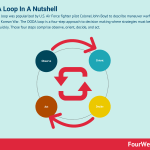
The OODA loop was popularized by U.S. Air Force fighter pilot Colonel John Boyd to describe maneuver warfare during the Korean War. The OODA loop is a four-step approach to decision making where strategies must be adjusted quickly. Those four steps comprise observe, orient, decide, and act.
Understanding the OODA loopBoyd noted that USAF pilots flying F-86 fighter jets were able to consistently down the Korean Mig-15 by a factor of 10 to 1. This was even though the Mig-15 was a technically superior aircraft, with better acceleration and higher climb rates.
However, the F-86 had two distinct advantages. Thanks to a hydraulic control system, it could transition from one maneuver to another in rapid succession. The canopy of the F-86 was also more expansive, allowing pilots to better observe and react more quickly in combat. Ultimately, the F-86 was the more agile of the two jets.
In the context of the OODA loop, agility is represented as a series of decision-making cycles. Businesses can use these cycles to solve specific problems quickly, thereby remaining competitive.
In the next section, we will look at the cycle in more detail.
Decision-making cycles of the OODA loopIn its simplest form, the OODA loop has four stages.
Stage 1 – ObserveWhat are the internal and external drivers of change? Where are the inflection points in trends?
Decision-makers must observe changes at the micro or macro level to determine whether a response is required. Drivers might include ever-increasing internet speeds or the continued replacement of jobs with technology and automation.
Stage 2 – OrientIs the business aligned with the observations made? Scenario planning is useful in ensuring that strategic plans are meeting expectations or challenging expectations.
This is the most important step because it determines how a business will position itself to take advantage of its observations. It’s also the step most vulnerable to bias, which has five main influences:
Cultural traditions.An ability to analyze and synthesize.Genetic heritage.New information.Previous experience.As a rule, each decision made in the orienting process must be based on evidence. Businesses must also understand the perspective of a competitor by using the five influences above. This, to some extent, can predict how a competitor will behave.
Stage 3 – DecideWhat is the most appropriate course of action?
Here, taking no action is sometimes the best choice. Indeed, businesses should avoid acting for the sake of it.
Since the OODA loop advocates quick decision making in fluid environments, businesses often cycle between Stage 1 and Stage 3 as more information becomes available.
Stage 4 – ActOnce a decision is made it is important to act quickly and implement it. The results of decision implementation are then fed back into the observation stage and their impact re-assessed.
Note also that the OODA loop is not a cyclical process but a series of iterative adjustments.
Businesses should also remember that it favors quick decision making to remain competitive. For some decisions where the cost of failure is high, a more considered approach is required.
For example, a relatively minor change in customer refund policy can be made quickly and adapted if required. But a significant product refresh has a higher cost of failure and as a result, would likely reduce competitiveness if not implemented properly.
Key takeawaysThe OODA loop is a quick, effective, and proactive decision-making process that allows businesses to remain competitive.The OODA loop is based on four stages that help decision-makers identify key drivers of change, identify unbiased solutions, and then implement the best course of action quickly.Despite its name, the OODA loop decision-making process is less of a loop and more a series of iterative and interactive adjustments. Businesses should also be careful not to rush important decisions where the cost of failure is high.Connected Business Frameworks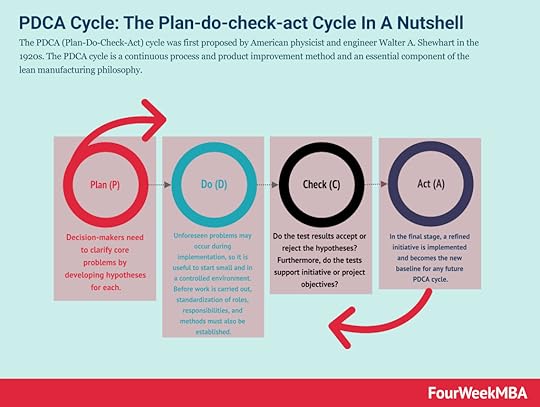 The PDCA (Plan-Do-Check-Act) cycle was first proposed by American physicist and engineer Walter A. Shewhart in the 1920s. The PDCA cycle is a continuous process and product improvement method and an essential component of the lean manufacturing philosophy.
The PDCA (Plan-Do-Check-Act) cycle was first proposed by American physicist and engineer Walter A. Shewhart in the 1920s. The PDCA cycle is a continuous process and product improvement method and an essential component of the lean manufacturing philosophy.  Agile Modeling (AM) is a methodology for modeling and documenting software-based systems. Agile Modeling is critical to the rapid and continuous delivery of software. It is a collection of values, principles, and practices that guide effective, lightweight software modeling.
Agile Modeling (AM) is a methodology for modeling and documenting software-based systems. Agile Modeling is critical to the rapid and continuous delivery of software. It is a collection of values, principles, and practices that guide effective, lightweight software modeling.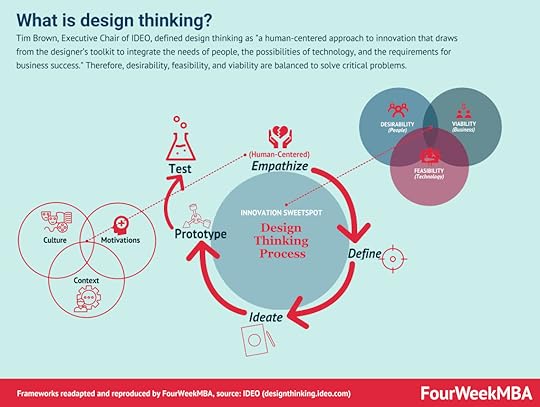 Tim Brown, Executive Chair of IDEO, defined design thinking as “a human-centered approach to innovation that draws from the designer’s toolkit to integrate the needs of people, the possibilities of technology, and the requirements for business success.” Therefore, desirability, feasibility, and viability are balanced to solve critical problems.
Tim Brown, Executive Chair of IDEO, defined design thinking as “a human-centered approach to innovation that draws from the designer’s toolkit to integrate the needs of people, the possibilities of technology, and the requirements for business success.” Therefore, desirability, feasibility, and viability are balanced to solve critical problems.  The take-the-best heuristic is a decision-making shortcut that helps an individual choose between several alternatives. The take-the-best (TTB) heuristic decides between two or more alternatives based on a single good attribute, otherwise known as a cue. In the process, less desirable attributes are ignored.
The take-the-best heuristic is a decision-making shortcut that helps an individual choose between several alternatives. The take-the-best (TTB) heuristic decides between two or more alternatives based on a single good attribute, otherwise known as a cue. In the process, less desirable attributes are ignored.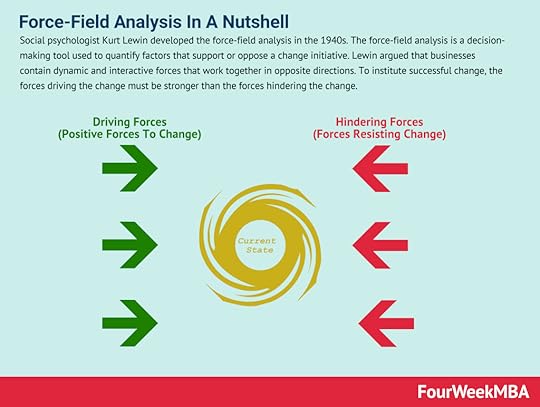 Social psychologist Kurt Lewin developed the force-field analysis in the 1940s. The force-field analysis is a decision-making tool used to quantify factors that support or oppose a change initiative. Lewin argued that businesses contain dynamic and interactive forces that work together in opposite directions. To institute successful change, the forces driving the change must be stronger than the forces hindering the change.
Social psychologist Kurt Lewin developed the force-field analysis in the 1940s. The force-field analysis is a decision-making tool used to quantify factors that support or oppose a change initiative. Lewin argued that businesses contain dynamic and interactive forces that work together in opposite directions. To institute successful change, the forces driving the change must be stronger than the forces hindering the change.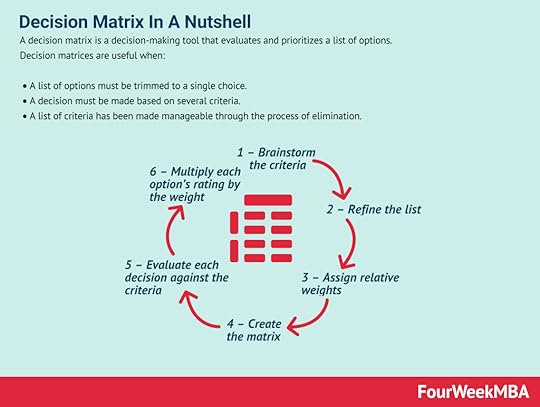 A decision matrix is a decision-making tool that evaluates and prioritizes a list of options. Decision matrices are useful when: A list of options must be trimmed to a single choice. A decision must be made based on several criteria. A list of criteria has been made manageable through the process of elimination.
A decision matrix is a decision-making tool that evaluates and prioritizes a list of options. Decision matrices are useful when: A list of options must be trimmed to a single choice. A decision must be made based on several criteria. A list of criteria has been made manageable through the process of elimination. The Pareto Analysis is a statistical analysis used in business decision-making that identifies a certain number of input factors that have the greatest impact on income. It is based on the similarly named Pareto Principle, which states that 80% of the effect of something can be attributed to just 20% of the drivers.
The Pareto Analysis is a statistical analysis used in business decision-making that identifies a certain number of input factors that have the greatest impact on income. It is based on the similarly named Pareto Principle, which states that 80% of the effect of something can be attributed to just 20% of the drivers. Businesses use scenario planning to make assumptions on future events and how their respective business environments may change in response to those future events. Therefore, scenario planning identifies specific uncertainties – or different realities and how they might affect future business operations. Scenario planning attempts at better strategic decision-making by avoiding two pitfalls: underprediction, and overprediction.
Businesses use scenario planning to make assumptions on future events and how their respective business environments may change in response to those future events. Therefore, scenario planning identifies specific uncertainties – or different realities and how they might affect future business operations. Scenario planning attempts at better strategic decision-making by avoiding two pitfalls: underprediction, and overprediction.Main Guides:
Business ModelsBusiness StrategyBusiness DevelopmentDistribution ChannelsMarketing StrategyPlatform Business ModelsNetwork EffectsMain Case Studies:
Amazon Business ModelApple Mission StatementNike Mission Statement Amazon Mission StatementApple DistributionThe post OODA Loop And Why It Matters In Business appeared first on FourWeekMBA.



